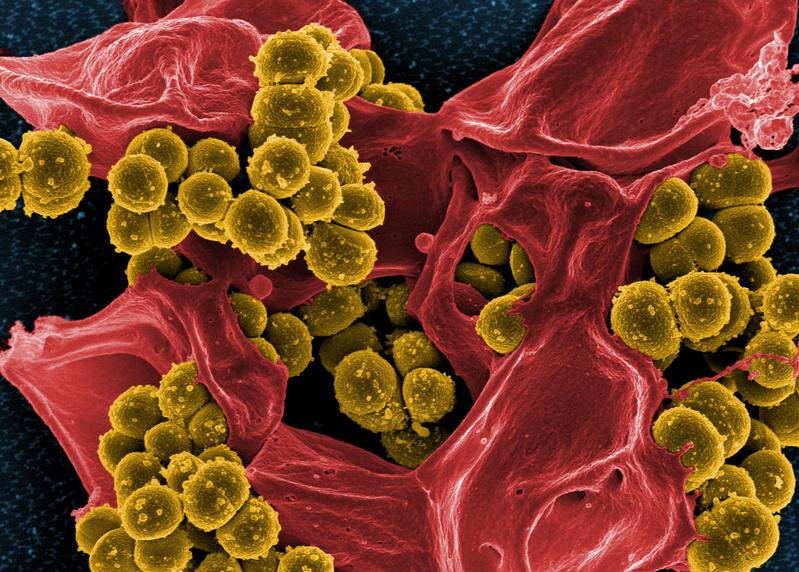

Methicillin-resistant Staphylococcus aureus (MRSA) (mustard-coloured) engulfed by a red coloured white blood cells (neutrophil granulocyte)
National Institute of Allergy and Infectious Diseases (NIAID)
Staphylococcus aureus (S. aureus) is a bacterium that colonizes by far more than half of the skin and the mucosa of adults, usually without causing infections. If, however, this bacterium overcomes the external barrier such as skin or the mucosa, thus, invading the body, it can cause infections.
Staphylococcus aureus is responsible for a variety of infections that occur in hospitals or care facilities. Some S. aureus strains develop resistances against multiple antibiotics. These so-called MRSAs (multi-resistant S. aureus) cause infections difficult to treat.
So far, all attempts to develop a protective vaccine against S. aureus have failed despite promising results in animal models. One reason might be that the mechanisms of the human immune response against this pathogen are so far not sufficiently understood. In healthy adults, specific immune cells of the adaptive immune system – so-called T-cells – can specifically recognise S. aureus.
There are different T-cells, distinguishable by their surface proteins, which are required for binding to antigen-presenting cells. It was already known that so-called CD4-postive (CD4 protein bearing) T-helper cells can be formed during the immune response against S. aureus. However, these CD4-positive T-cells are not effective against bacteria loacted within cells.
The situation is different for CD8-positive T-cells. They recognise fragments of bacteria which have been processed within the cell and are presented on the surface and provoke the killing of these infected cells. Researchers at the PEI under the supervision of Priv.-Doz. Dr Isabelle Bekeredjian-Ding (MD), head of Division Microbiology demonstrated for the first time that specific CD8-positive T-cells against S. aureus are also formed by the immune system.
However, when examining this T-cell subtype, the researchers realised that when getting into contact with S. aureus, these cells produced substances that did not support the elimination of the pathogen. Instead, the type of released messenger substances assumes that they contribute to immune tolerance against the bacterium by influencing so-called regulatory T-cells and type-2 helper cells. Such influenced regulatory T-cells can prevent or inhibit the activation of the immune response, thus controlling tolerance of the immune system. That way, they can prevent the elimination of the bacterium.
In addition, the PEI researchers were able to show that S. aureus mediated the production of factor G-CSF (Granulocyte-Colony Stimulating Factor) which is, among other things, released during inflammations of the body and inhibits inflammatory T-cell responses. However, the researchers did not only detect T-cell responses that inhibited immunity but also T-cell responses to S. aureus, which were able to start inflammatory processes and could in principle induce the clearance of the pathogenic agent. However, their ratio compared with regulatory T-cells was so low that their effect was negligible.
Dr Bekeredjian-Ding and colleagues were able to show now how this ratio can be shifted in favour of a stronger immune response against S. aureus: The proinflammatory T-cell response could be enhanced by adding immune-active S. aureus components, so-called antigens, which were formed by delivery of messenger RNA (mRNA) of the pathogen into certain immune cells. The use of mRNA produced in the laboratory as a source of antigen is already a well-established method of treatment to induce T-cell responses in tumour therapy to kill infected cells. “Our results show that , in fact, an immune memory against Staphylococcus aureus does exist. We consider it as possible that mRNA-containing vaccines can be used to alter T-cell responses against these pathogens in the body and to increase the portion of protective T-cells”, explained Dr Bekeredjian-Ding when presenting the results.
Original Publication
Uebele J, Stein C, Nguyen MT, Schneider A, Kleinert F, Tichá O, Bierbaum G, Götz F, Bekeredjian-Ding I (2017): Antigen delivery to dendritic cells shapes human CD4+ and CD8+ T cell memory responses to Staphylococcus aureus.
PLOS Pathog May 25 [Epub ahead of print].
http://journals.plos.org/plospathogens/article?id=10.1371/journal.ppat.1006387












